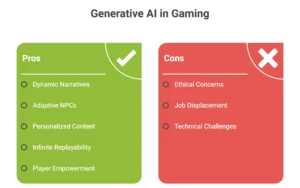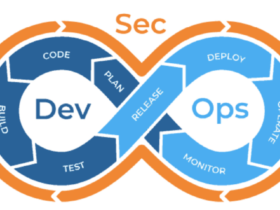The gaming industry stands on the precipice of a monumental transformation, driven by the explosive capabilities of Artificial Intelligence. At the forefront of this revolution is Generative AI in Gaming, a powerful technological paradigm that enables AI models to create novel content, from intricate game worlds and character dialogues to complex storylines and realistic assets. As of mid-2025, Generative AI is no longer a futuristic concept; it’s actively reshaping how games are made, how players experience them, and the very boundaries of interactive entertainment, promising unprecedented levels of creativity, personalization, and efficiency.
What is Generative AI in Gaming?
Generative AI refers to a class of artificial intelligence models, such as Large Language Models (LLMs) and diffusion models, that can produce new, original content based on patterns learned from vast datasets. When applied to gaming, Generative AI in Gaming means that instead of human developers painstakingly crafting every pixel, line of dialogue, or environmental detail, AI can assist or even autonomously generate these elements.
This capability moves beyond traditional procedural generation, which often relies on predefined rules and algorithms to create variations of existing structures. Generative AI, by contrast, can understand context, style, and intent, allowing it to create truly novel and contextually relevant content. It’s about AI becoming a creative partner in the game development process and an enabler of dynamic, ever-evolving player experiences.
How Generative AI is Transforming Game Development
The impact of Generative AI in Gaming on the development pipeline is profound, promising to accelerate creation, reduce costs, and empower smaller teams to produce richer games.
This shift transforms developers from mere creators into “orchestrators” and “curators” of AI-generated content, focusing on guiding the AI and refining its output.
Enhancing Gameplay and Player Experiences
Beyond development, Generative AI in Gaming is poised to revolutionize the actual experience of playing games, offering unprecedented immersion and personalization.
- Dynamic and Adaptive Narratives : Imagine a game where the story isn’t pre-written but evolves based on your choices, actions, and even your personality. Generative AI can create branching storylines, emergent events, and personalized character interactions that make each playthrough unique. NPCs can remember past conversations, react to your reputation, and even hold grudges or develop friendships, leading to truly dynamic relationships.
- Adaptive Non-Player Characters (NPCs) : NPCs powered by generative AI can exhibit more realistic, nuanced, and unpredictable behaviors. They can learn from player actions, adapt their strategies, and engage in more natural and complex conversations. This moves beyond scripted responses to truly emergent behavior, making the game world feel more alive and responsive.
- Hyper-Personalized Content : Generative AI can tailor game content specifically for individual players. This could include:
- Custom Quests: AI generating quests that align with a player’s preferred playstyle, character build, or even their emotional state.
- Personalized Item Generation : Creating unique weapon stats, gear appearances, or loot based on player preferences or progression.
- Adaptive Difficulty : AI systems that subtly adjust the game’s challenge in real-time to match a player’s skill level and prevent frustration or boredom.
- Infinite Replayability: By generating new levels, quests, characters, and storylines on the fly, games can offer virtually endless content, providing fresh experiences every time a player engages with the title. This dramatically increases the value and longevity of games.
- Player-Generated Content (PGC) Empowerment: Generative AI tools can empower players themselves to create complex mods, custom levels, or even entire narrative branches with much less technical expertise, fostering vibrant communities and expanding game universes. This democratizes content creation within games.

These innovations promise a gaming future where the line between authored and generated content blurs, leading to richer, more surprising, and deeply personal experiences for every player.
Benefits of Integrating Generative AI
The integration of Generative AI in Gaming offers compelling advantages for both developers and players.
This transformative potential is driving significant investment and innovation in the sector.
Challenges and Ethical Considerations
Despite its immense promise, the widespread adoption of Generative AI in Gaming also introduces a unique set of challenges and ethical considerations that developers and the industry must carefully navigate.
- Quality Control and Consistency: While AI can generate vast amounts of content, ensuring its quality, coherence, and artistic consistency with the game’s overall vision remains a significant hurdle. AI “hallucinations” or nonsensical output can break immersion.
- The “Uncanny Valley” for NPCs: Generative AI can create highly realistic human-like characters and voices, but slight imperfections can lead to an unsettling “uncanny valley” effect, where characters are almost, but not quite, human, causing discomfort for players.
- Copyright and IP Issues: The data used to train generative AI models often includes copyrighted material. This raises complex legal questions about the ownership of AI-generated content and potential infringement claims against the training data’s original creators. This is a major ongoing debate in the creative industries.
- Ethical Bias and Representation: If training data contains biases (e.g., stereotypical representations of gender, race, or culture), the AI can perpetuate these biases in generated characters, storylines, or content, leading to harmful or offensive outcomes.
- Computational Demands and Cost: Training and running advanced generative AI models can be extremely computationally intensive and expensive, requiring significant hardware and cloud resources.
- Developer Skill Shift and Job Impact: While AI creates new roles (AI trainers, prompt engineers, AI ethicists), it may also shift or diminish demand for certain traditional creative roles. Developers need to adapt and integrate AI tools into their workflows.
- Loss of Human Touch/Artistic Vision: Over-reliance on generative AI could potentially dilute the unique artistic vision and human touch that often define truly beloved games, leading to a more generic or soulless output.
- Player Acceptance: Will players embrace dynamically generated content as readily as handcrafted experiences? Trust in the integrity and quality of AI-generated elements will be crucial.
Addressing these challenges requires a thoughtful, interdisciplinary approach, blending technological innovation with ethical guidelines and responsible development practices. For further reading on the ethical implications, see articles discussing AI ethics in game development.
The Future of Generative AI in Gaming
The trajectory of Generative AI in Gaming suggests an increasingly sophisticated and integrated role in the industry’s future.
- Hyper-Realistic & Dynamic Worlds: Expect future games to feature seamless, endlessly generating worlds that are not only vast but also logically consistent and filled with dynamic ecosystems, weather patterns, and NPC behaviors.
- True Interactive Storytelling: Beyond branching narratives, AI will enable emergent storytelling where the plot truly adapts and reacts to nuanced player interactions, emotional states, and even conversations, creating unique, “unscripted” sagas for each player.
- AI Companions with Deep Personalities: NPCs will evolve into truly intelligent companions with persistent memory, learning capabilities, and dynamic personalities that foster deep emotional connections with players.
- Personalized Game Engines: Game engines themselves might become AI-driven, adapting their rendering, physics, and content generation pipelines in real-time based on player preferences and hardware capabilities.
- Player-Empowered Creation: Tools for players to generate highly detailed and unique in-game content will become more intuitive and powerful, blurring the lines between player and developer. This could lead to entirely new genres centered around AI-assisted content creation.
- Ethical AI by Design: As the technology matures, there will be a stronger emphasis on “Responsible AI” frameworks integrated into the earliest stages of game development, ensuring fairness, transparency, and player well-being are prioritized.
The future of gaming, powered by generative AI, promises a realm of limitless creativity and unparalleled player immersion, where every playthrough is a unique journey.
Generative AI in Gaming is not just an incremental improvement; it’s a paradigm shift that redefines the very fabric of game creation and player experience. By automating content generation, enabling dynamic narratives, and facilitating deep personalization, AI is set to unlock unprecedented levels of efficiency for developers and infinite replayability for players. While challenges related to quality control, ethics, and computational demands must be meticulously addressed, the trajectory is clear: Generative AI will be a cornerstone of future gaming, pushing the boundaries of creativity and interactivity in ways we are only just beginning to imagine. Prepare to play in worlds that truly learn and evolve with you.
Stay ahead of the curve on the latest advancements in AI, gaming, and technology. Explore more of our insightful articles and analyses at jurnalin.










اترك رد